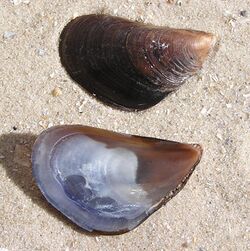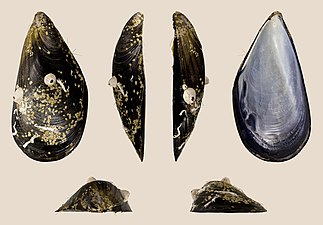Biology:Mediterranean mussel
| Mediterranean mussel | |
|---|---|

| |
| Two valves of Mytilus galloprovincialis | |
| Scientific classification | |
| Domain: | Eukaryota |
| Kingdom: | Animalia |
| Phylum: | Mollusca |
| Class: | Bivalvia |
| Order: | Mytilida |
| Family: | Mytilidae |
| Genus: | Mytilus |
| Species: | M. galloprovincialis
|
| Binomial name | |
| Mytilus galloprovincialis Lamarck, 1819
| |
The Mediterranean mussel (Mytilus galloprovincialis) is a species of bivalve, a marine mollusc in the family Mytilidae. It is an invasive species in many parts of the world, and also an object of aquaculture.[1]
Systematics
Mytilus galloprovincialis is one of the three principal, closely related species in the Mytilus edulis complex of blue mussels, which collectively are widely distributed on the temperate to subarctic coasts of both the Northern and Southern Hemispheres, and often are dominant inhabitants on hard substrates of the intertidal and nearshore habitats. M. galloprovincialis will often hybridize with its sister taxa, the closely related Mytilus edulis and Mytilus trossulus, when they are found in the same locality. M. galloprovincialis is considered the most warm-water-tolerant species of the three, and has the most southerly distribution in Europe and North America.
Distribution
In Europe, Mytilus galloprovincialis is found in the Mediterranean Sea and the Black Sea, and on the Atlantic coasts, in Portugal, north to France and the British Isles and Norway. Recently this species has also been found in the European Arctic including northern Norway and Svalbard.[2]
In the northern Pacific the species is found along the coast of California , where it was introduced from Europe by human activity in the early 20th century, and also in the Puget Sound region of Washington (state) , where it has been subject to aquaculture.[3] It is also present as an invasive species on the Asian coast throughout Japan , including Ryukyu Islands, as well as in North Korea[4] and around Vladivostok in Russia.
Mytilus galloprovincialis is also present as a native lineage in parts of the Southern Hemisphere. In addition there are populations introduced from the north recently with human activity. These lineages are distinguished by genetic characters. No original Mytilus populations lived in South Africa , but the Mediterranean mussel was introduced from Europe in 1984 and is now the dominant low intertidal mussel on the West Coast. The distribution spans an area from the Namibian border to Port Alfred, intertidally to just below the low tide border.[5] M. galloprovincialis is also found in New Zealand, Australia and South America.
Description
This animal grows up to 140 mm in length. It is a smooth-shelled mussel with a slightly broader base than that of the black mussel (Choromytilus meridionalis), with which it is often confused in South Africa. Its shell is blue-violet[1] or black, but may shade to light brown.[6]
Ecology
The Mediterranean mussel is a filter feeder. It is rare subtidally, which is an alternate means of distinguishing it from the black mussel in South Africa.
Mussels are generally considered as a bioindicators of the whole ecosystem in which they live. The immune system of bivalve molluscs is often chosen as a target parameter to evaluate the welfare of the species and of their surrounding environment.[7] In the Adriatic Sea, Chamelea gallina and Mytilus galloprovincialis share similar variations of the cytotoxic activity during the year. The exertions by the hemolymph of the species are considered a useful biomarker of the immune activity and therefore of the health of mussels.[7]
The immune systems of the clam Chamelea gallina and the mussel Mytilus galloprovincialis are influenced by changing environmental parameters such as water acidification, temperature increases and variations in seawater salinity. Those properties describe a typical scenario of the global climate change and bivalve molluscs are considered predictors of its future impact on the health status of both wild and farmed organisms.[8]
Mariculture
Novigrad Mussel
Novigrad Mussel is M. galloprovincialis cultivated in farms in the Novigrad Sea and Novsko Ždrilo in Croatia and product of the Croatian cuisine with European protected designation of origin, conferred by the European Commission.[9] Although Adriatic sea is oligotrophic, estuaric position of Novigrad makes it suitable for aquaculture.[10]
The shell of the Novigrad Mussel has a fan-shaped, triangular, or elongated-oval shape. The body is enclosed by two equal shells, externally black-blueish in color, and internally pale pearly. The length of the longest part of a consumable-sized shellfish is at least 6 cm, while the minimum weight of a shellfish is 20 g. It is particularly known for its high condition index, which is at least 12%. Fresh meat is smooth to the touch, with a soft and elastic consistency, carrying a characteristic scent of the marine algae. The surface of the meat is shiny, moist, and smooth.[9]
References
- ↑ 1.0 1.1 Mytilus galloprovincialis (mollusc) Global Invasive Species Database. issg.org
- ↑ Mathiesen, Sofie Smedegaard; Thyrring, Jakob; Hemmer-Hansen, Jakob; Berge, Jørgen; Sukhotin, Alexey; Leopold, Peter; Bekaert, Michaël; Sejr, Mikael Kristian et al. (August 2016). "Genetic diversity and connectivity within spp. in the subarctic and Arctic". Evolutionary Applications 10 (1): 39–55. doi:10.1111/eva.12415. PMID 28035234.
- ↑ Thomas J. Hilbish, Pamela M. Brannock, Karlie R. Jones, Allison B. Smith, Brooke N. Bullock and David S. Wethey (2010) Historical changes in the distributions of invasive and endemic marine invertebrates are contrary to global warming predictions: the effects of decadal climate oscillations. Journal of Biogeography 37:423–431.
- ↑ Mytilus galloprovincialis www.nies.go.jp
- ↑ Branch, G.M., Branch, M.L, Griffiths, C.L. & Beckley, L.E (2005). Two Oceans: a guide to the marine life of southern Africa ISBN:0-86486-672-0
- ↑ Day, J.H. 1969. Marine Life on South African Shores Balkema, Cape Town
- ↑ 7.0 7.1 D Malagoli; L Casarini; F Fiori; E Ottaviani (2008). "Cytotoxic activity by the mussel Mytilus galloprovincialis and the Venus clam Chamelea gallina in the Adriatic sea in 2007". Invertebrate Survival Journal 5 (1): 50–53. ISSN 1824-307X. OCLC 8615572059. http://www.isj.unimo.it/articoli/ISJ162.pdf. Retrieved October 17, 2020. (at p. 50 and in the abstract).
- ↑ Valerio Matozzo; Andrea Chinellato; Marco Munari; Livio Finos; Monica Bressan; Maria Gabriella Marin (2012). "First Evidence of Immunomodulation in Bivalves under Seawater Acidification and Increased Temperature". PLOS ONE 7 (3): e33820. doi:10.1371/journal.pone.0033820. ISSN 1932-6203. OCLC 805433147. PMID 22479452. Bibcode: 2012PLoSO...733820M.
- ↑ 9.0 9.1 "Novigrad Mussel becomes 43rd Croatian product protected". Croatia Week. 28 June 2023. https://www.croatiaweek.com/novigrad-mussel-becomes-43rd-croatian-product-protected/.
- ↑ Župan, Ivan; Šarić, Tomislav; Mokos, Melita; Gangemi, Jessica; Cipriano, Agnese. "COMPARISON OF MUSSEL PRODUCTION PARAMETERS FROM TRADITIONAL AND IMTA SITESIN THE ADRIATIC SEA (CROATIA)". https://scholar.googleusercontent.com/scholar?q=cache:JlgtnuCRL6cJ:scholar.google.com/+Novigrad+Mussle&hl=hr&as_sdt=0,5.
External links
- .issg.org/database/species/references.asp?si=102&fr=1&sts=&lang=EN Mytilus galloprovincialis Selection of references. www.issg.org
- Mytilus galloprovincialis (Lamarck, 1819) FAO Fisheries and Aquaculture, Cultured Aquatic Species Information Programme
- Picture of a British specimen habitas.org
Wikidata ☰ Q943341 entry
 |



